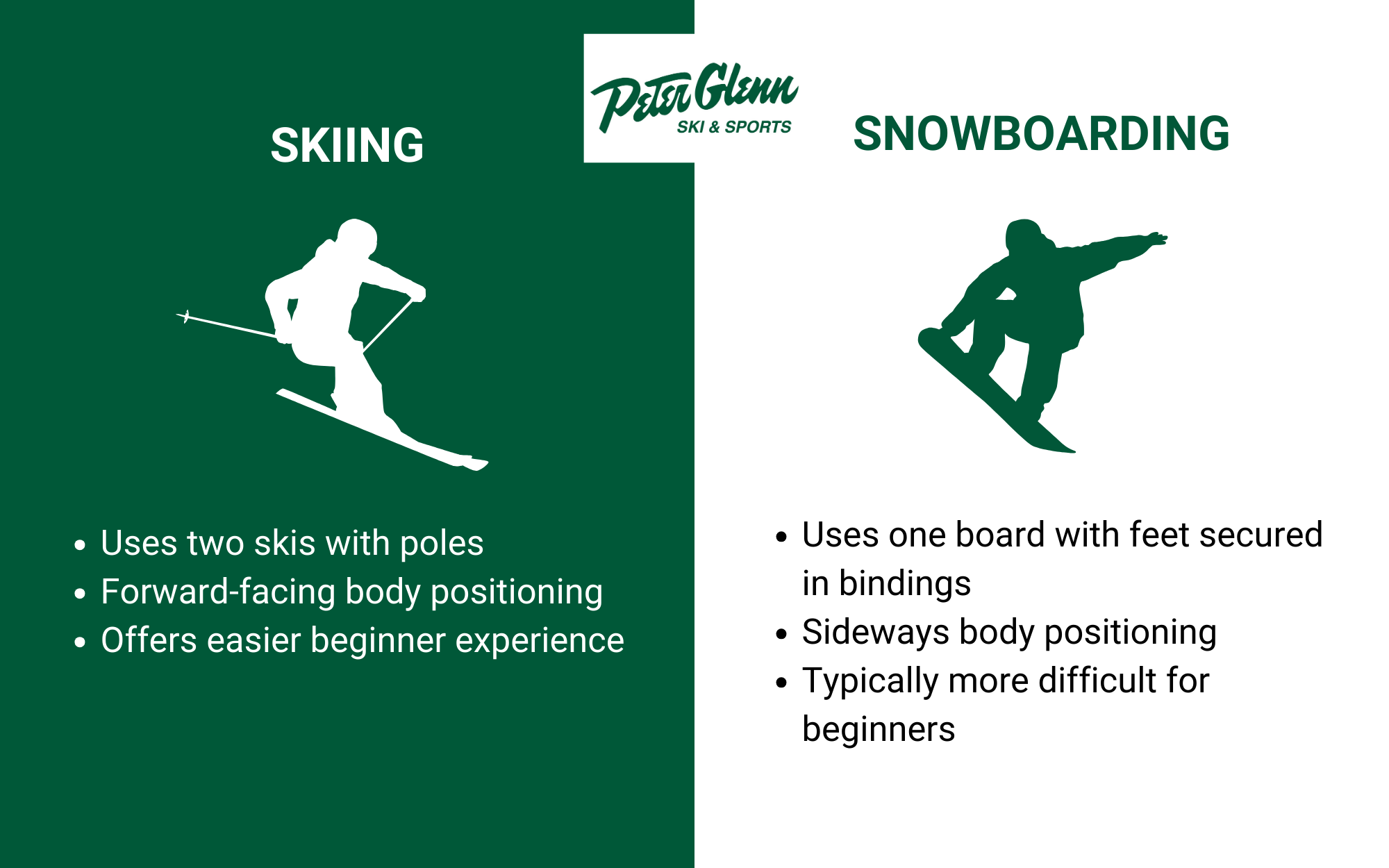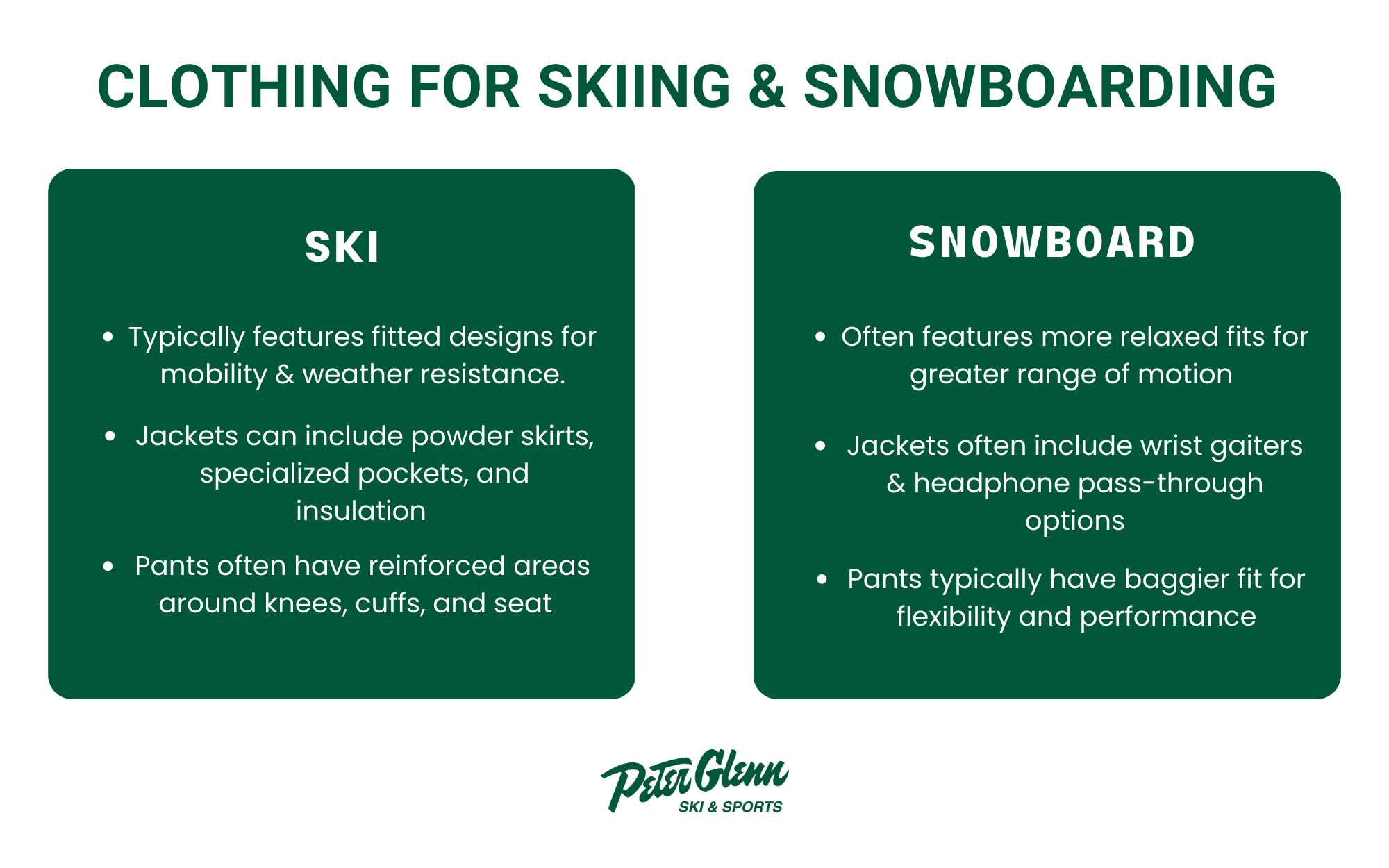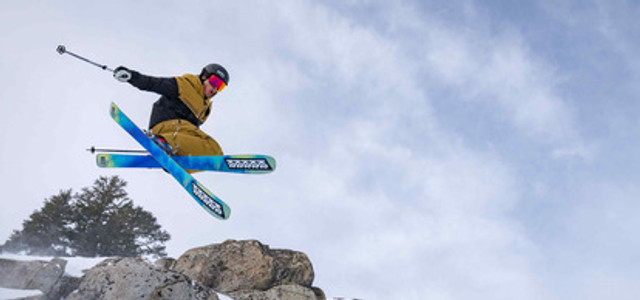Skiing vs Snowboarding: Choosing the Right Gear, Clothing, & More
Posted by Peter Glenn Staff on Aug 27th 2025
At a Glance: Skiing uses two separate skis with poles and offers easier initial learning, while snowboarding involves riding a single board sideways with a steeper learning curve. The main differences lie in equipment (skis vs. snowboards), body positioning (forward-facing vs. sideways), and clothing fits (fitted ski wear vs. baggier snowboard styles), though both sports require similar layering systems and safety gear.
Both skiing and snowboarding offer exhilarating ways to experience the mountain, but each sport comes with distinct techniques, equipment requirements, and learning curves. Each sport has evolved its own culture and specialized equipment designed to enhance proper technique and safety. Understanding the differences between these activities helps winter adventurers find gear, clothing, and accessories that will keep them comfortable on the slopes.

Understanding the Difference
Each sport offers unique challenges and opportunities to learn advanced skills, but the most fundamental difference between skiing and snowboarding lies in how you navigate down the mountain.
Skiing Basics
Skiing focuses on precision, edge control, and efficient energy transfer. It involves using two separate skis attached to each foot, with poles in each hand for balance and propulsion. Skiers face downhill with their body positioned forward, allowing for independent leg movement and the ability to shift weight from ski to ski.
Skiing generally offers an easier initial experience for beginners since the ability to move legs independently and use poles for balance feels more natural. Many new skiers can navigate beginner slopes within their first day.
Snowboarding Basics
Snowboarding emphasizes flexibility, edge hold, and board feel. It involves riding a single board with both feet secured in bindings, typically positioned sideways to the direction of travel. Snowboarders must learn to balance on one edge or the other, using their entire body to initiate turns through weight shifts and edge control.
Snowboarding typically presents a steeper initial learning curve, with beginner snowboarders often spending additional time learning to balance and link turns. However, this can depend on personal preference and the terrain conditions.
Differences in Types of Equipment & Gear
The equipment requirements for skiing and snowboarding are distinctly different, since each sport has its respective techniques and safety needs.
Skiing Equipment
Skis themselves come in various lengths and widths depending on skill level, terrain preference, and skiing style.
Skis
Modern skis incorporate advanced materials for improved stability and responsiveness. All-mountain skis work well for general recreation, while specialized options include racing skis, powder skis, and freestyle skis.
Ski Boots
These are rigid and designed to transfer energy efficiently from your legs to the skis, connecting to bindings that release during falls for injury prevention.
Ski Poles
These assist with balance, timing, and propulsion, with lengths typically reaching somewhere between your armpit and shoulder when standing upright.
Ski Bindings
These feature sophisticated release mechanisms calibrated to individual skier weight, ability, and skiing style to prioritize safety on the slopes.

Snowboarding Equipment
Snowboarding centers around the snowboard itself, which varies in length, width, and flex pattern based on riding style and terrain preferences.
Snowboards
Snowboard flex patterns range from soft to stiff, affecting how the board responds to rider input. All-mountain boards offer versatility for a variety of snowboarding conditions, while freestyle boards are designed for maneuverability and are often used for terrain parks and halfpipes. Board shapes vary from traditional directional boards to twin-tip freestyle boards and asymmetrical designs for specialized applications.
Snowboard Boots
Generally softer and more comfortable than ski boots, these are designed for flexibility rather than rigid energy transfer.
Snowboard Bindings
These secure the boots to the board and come in various styles, from traditional strap bindings to newer step-on systems.
Safety Equipment
Both skiing and snowboarding require helmets for head protection, but wrist guards are particularly common among snowboarders due to the increased likelihood of catching falls with outstretched hands. Back protectors and other protective features are available for both sports, especially for those tackling more aggressive terrain.

Differences in Types of Clothing
While both winter sports require similar base layers and insulation principles, specific clothing considerations vary between skiing and snowboarding based on the unique movements, stances, and culture of each sport.
Ski Clothing
Ski wear typically emphasizes fitted clothing that allows for mobility and articulation around the knee and hip areas to accommodate the skiing stance.
- Ski Jackets: Ski jackets frequently have powder skirts and specialized pockets for goggles and lift tickets.
- Ski Pants: These often feature reinforced areas around the cuffs, knees, and seat of the pants.
- Ski Accessories: These include items like ski straps, helmet liners, wrist guards, thermal socks, neck gaiters, gloves, and hats that boost performance and offer additional warmth in varying weather conditions.
Snowboard Clothing
Snowboarding tends to prioritize a different fit and style, often featuring baggier cuts that allow for the greater range of motion required for snowboarding movements.
- Snowboard Jackets: Many snowboard-specific jackets include features like wrist gaiters, headphone pass-through, and pass pockets positioned for easy access while wearing a backpack.
- Snowboard Pants: These typically have reinforced knees and seat areas where contact with snow is more frequent during learning and falling.
- Snowboard Accessories: Goggles, helmets, hats, and neck gaiters are some of the most frequently used add-ons for snowboarding.
Layering Systems
These systems remain consistent between both sports, focusing on moisture-wicking base layers, insulating mid-layers, and waterproof and breathable outer shells. However, snowboarders often prefer slightly more relaxed fits to accommodate their riding movements, while skiers might choose more fitted options for improved aerodynamics and reduced wind resistance.
Find Skiing & Snowboarding Gear, Clothing, & More at Peter Glenn
Both skiing and snowboarding offer lifetime learning opportunities and access to incredible mountain experiences. If you’re just starting out or you’re looking to take it to the next level, having access to high-quality clothing and gear from trusted brands makes all the difference. At Peter Glenn, we understand that the right equipment not only enhances performance but also builds confidence and safety on the slopes. We carry comprehensive selections for both skiing and snowboarding, and our staff can provide personalized guidance on equipment selection, proper fit, and performance optimization for both sports. View our full Ski and Snowboard collections or visit one of our eight locations to explore our extensive collection of outdoor gear.



